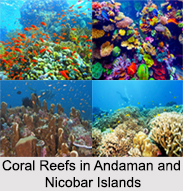 The Andaman and Nicobar Islands, nestled in the Bay of Bengal, are renowned for their stunning coral reefs, boasting a rich tapestry of marine life and vibrant colors. These Coral reefs trace their formations in the Pre-historic age. Home to an impressive array of over 560 coral species, these underwater ecosystems hold a mesmerizing allure for those who explore their depths. Corals, minuscule organisms, play a pivotal role in the creation of coral reefs. They secrete massive calcareous skeletons and collectively deposit calcium carbonate, giving rise to expansive colonies. Encompassing approximately 2,000 square kilometers, these coral reefs span nearly six percent of the total land area of the Andaman and Nicobar Islands. These underwater landscapes comprise fringing reefs along the eastern side and barrier reefs along the western, offering a captivating spectacle to beholders. Within these reefs, a diverse community thrives, featuring corals, clams, sponges, snails, anemones, crabs, starfish, worms, shrimps, lobsters, and an assortment of fish species such as damselfish, groupers, surgeonfish, and butterfly fish.
The Andaman and Nicobar Islands, nestled in the Bay of Bengal, are renowned for their stunning coral reefs, boasting a rich tapestry of marine life and vibrant colors. These Coral reefs trace their formations in the Pre-historic age. Home to an impressive array of over 560 coral species, these underwater ecosystems hold a mesmerizing allure for those who explore their depths. Corals, minuscule organisms, play a pivotal role in the creation of coral reefs. They secrete massive calcareous skeletons and collectively deposit calcium carbonate, giving rise to expansive colonies. Encompassing approximately 2,000 square kilometers, these coral reefs span nearly six percent of the total land area of the Andaman and Nicobar Islands. These underwater landscapes comprise fringing reefs along the eastern side and barrier reefs along the western, offering a captivating spectacle to beholders. Within these reefs, a diverse community thrives, featuring corals, clams, sponges, snails, anemones, crabs, starfish, worms, shrimps, lobsters, and an assortment of fish species such as damselfish, groupers, surgeonfish, and butterfly fish.
Famous coral reefs of Andaman and Nicobar Islands
Nemo Reef, located off beach number 3 in Havelock, stands out as one of the most renowned coral reef sites in the region. This shallow reef primarily serves as an ideal location for discovery dives. While exploring its depths, divers can encounter colorful schools of fish, shrimps, sea cucumbers, and other marine wonders in the pristine blue-green waters.
Mushroom Corals
The corals appear like mushroom. Fungia species are solitary and lie free on the substrate. They are known to be able to move about on a reef. Other important mushroom corals are “Heliofungia actinimorphisâ€, “Herpolitha Umax†and “Polyphyllia talpinaâ€.
Diverse Coral Varieties
The Andaman and Nicobar Islands distinguish themselves on a regional scale by virtue of their remarkable coral species diversity and the preservation of intact corals. Among the various coral types found here, hard corals take center stage. Comprising rigid calcium carbonate structures, these corals bear a striking resemblance to rocks, with their polyps` exoskeletons composed of limestone. Additionally, the region is home to several notable coral described below.
Brain Corals
Brain corals are large boulder -shaped corals with appearance of brain. Some brain coral species are Lobophyllia sp., Symphyllia sp. etc.
Octo Corals
Octo coral has a hard skeleton arranged in upright elongated flat curved plates. It contains an iron pigment and internally is coloured blue. The external colour is light grey.
Branching Corals: Characterized by numerous branches, often adorned with secondary branches, these corals belong to the Acroporidae family and form expansive colonies.
Larger Star Coral: Scientifically known as "Favites abdita," the larger star coral is a stony coral species native to the Indo-Pacific region and belongs to the family Merulinidae.
Boulder-Shaped Corals: Commonly found on reef flats, boulder corals encompass diverse types, including pore corals and knob corals.
Finger Coral: Recognizable as "Porites porites," this species is colloquially referred to as hump coral or finger coral. It belongs to the genus Porites and is a stony coral thriving in shallow reef environments.
Cauliflower Coral: Known as "Pocillopora meandrina," cauliflower coral is another species of coral found in the Indo-Pacific and Pacific oceans. This coral is adapted to living in shallow reef environments, contributing to the captivating mosaic of marine life in the Andaman and Nicobar Islands.
Reef Community
The group of animals and plants found in a reef is known as the reef community.
Reef Builders
Reef builders comprise organisms which contribute to the building of a reef. Their lime-stone skeletons are the major component of the calcareous matter which forms a coral reef. Another reef builder is the calcareous red algae which help in binding coral skeleton and strengthen them against erosion. In addition, some green algae help in consolidating reef sediments.
Reef Dwellers
Reef dwellers do not help in reef formation but take part in energy transfer in a reef community`s food webs. They may be either resident species which remain in the reef throughout their life or may be visiting species which spend only part of their lives in the reef, often for breeding purpose or for searching specific food available in the reef.
Common Coelenterate Reef
These coral dwellers are jelly fish and sea-anemone. The jelly fishes do not stay around coral reefs all the time but during certain season they appear in large number. Some are capable of inflicting very severe stings which can cause shock to swimmers who are allergic.
Crustacean Dwellers in Coral reefs
The crustacean dwellers include a variety of crabs, lobsters and shrimps. The mollusks include the Top Shell, Turban Shell, Sacred Chunk, Cowries, Black Lip Pearl Oyster, Giant Clam etc.
Star Fishes in Coral reefs
The echinoderms include common star fish and brittle stars. These are the popular star fishes. These star fishes are residing here.






